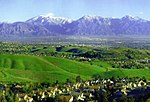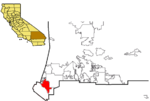2008 Chino Hills earthquake
2008 earthquakes2008 in California2008 natural disasters in the United StatesChino Hills, CaliforniaChino Hills (California) ... and 3 more
Earthquakes in CaliforniaJuly 2008 events in the United StatesUse mdy dates from February 2023

The 2008 Chino Hills earthquake occurred at 11:42:15 am PDT (18:42:15 UTC) on July 29 in Southern California. The epicenter of the magnitude 5.4 earthquake was in Chino Hills, c. 28 miles (45 km) east-southeast of downtown Los Angeles. Movement on an oblique-slip fault resulted in a maximum Mercalli intensity of VI (Strong). Though there were no deaths, eight people were injured, and it caused considerable damage in numerous structures throughout the area and caused some amusement park facilities to shut down their rides. The earthquake led to increased discussion regarding the possibility of a stronger earthquake in the future.
Excerpt from the Wikipedia article 2008 Chino Hills earthquake (License: CC BY-SA 3.0, Authors, Images).2008 Chino Hills earthquake
Trotter Terrace,
Geographical coordinates (GPS) Address Nearby Places Show on map
Geographical coordinates (GPS)
| Latitude | Longitude |
|---|---|
| N 33.953 ° | E -117.761 ° |
Address
Trotter Terrace 1967
91709
California, United States
Open on Google Maps




